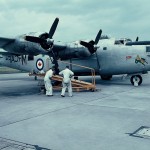
Europe B24
The war was a great awakening period for Canada’s aviation industry. The expansion of airports, manufacturing and operations made Canada a world power in aviation. The geographic location also helped Canadians become world leaders in air transport. The following quote from an aviation article demonstrates that even the prime minister of the day saw aviation as a future industrial leader.
“The Canadian government strongly favours a policy of international collaboration and co-operation in air transport and is prepared to support in international negotiations whatever international air transport policy can be demonstrated as being best calculated to serve not only the immediate national interests of Canada but also our overriding interest in the establishment of an international order which will prevent the outbreak of another world war.
The exact form of the final settlement is as yet undefined, but Canada has led the way by making public her ideas on the shape of a World Aeronautics Authority. The minimum seems to be an Authority, with power to regulate safety standards, ground- based organizations, and licensing of aircraft, crews and ground personnel, so as to provide uniform standards throughout the world’s airway system.
In the Canadian draft for the World Convention, more far reaching power is proposed of licensing air routes; the provision of machinery for arbitration; the definition of the ‘Freedom of the Air’; the defining of international air routes; power of audit and publicity on expenditures and revenues of airline operation; and the prevention of unfair practices. Any Convention agreed on might also set up international operating organizations to operate certain strategic routes. Some such action will obviously be necessary in the case of the European airlines, and this principle may be extended to other air routes as well.
What form Canadian participation in these important world routes will take cannot yet be determined but the weight of our government will be emphatically in the direction of ‘international collaboration and co-operation’ with the other interested nations.
These problems must necessarily await the assembling of an international conference to consider the future of the world’s airways, but, Canada, as the fourth air power in the world, will undoubtedly play a part commensurate with her past aviation experience, her wartime effort in the air and her strategic position on the world’s airways. In the domestic field, our future is in our own hands, and we have several great advantages which were lacking 25 years ago at the close of the last war.
The most important of all is the awakening of public opinion in all parts of the country to the advantages of air transportation. There are today few who remain unconvinced on this score. Indeed, our danger may be that public opinion has been unduly stimulated by the war activities may expect almost too much from aviation. In peace time, financial consideration inevitably has greater weight than in war time and every effort must be made to balance expenditures with revenues. Public opinion will, however,
Be much better prepared for the proposals to expand civil aviation than it was a generation ago. The second great advantage is the immense pool of personnel which will be available for the conduct of civil air services, the manufacturing industry and allied activities. We will have available for the first time thousands of young men and women who will ask nothing better than to continue their career in aviation and who have experience and skills to enable them to play a profitable part in it from the outset.
The third advantage we have is the tremendous expansion of our material facilities in the way of airports, hangars, shops, aircraft factories, radio stations, weather observing posts, traffic control facilities, and the thousand and one activities which go to make up an efficient air transport service. These factors will all be invaluable and should greatly facilitate our work in the future.
Another very favourable factor is that due to the policy of making use of civil organizations in the war effort where this could be done to advantage, all our civil operating firms have been immensely strengthened by their war experience, which should stand industry in good stead in the post war years. Everywhere else in the world civil operations have largely disappeared. This is true in Europe, Africa, the Middle and Far East, and Australia, but in Canada, thanks to the wise policy of the Government, all civil operators have been maintained in being and have benefited greatly by the wider experience of war operations.
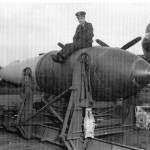
Grand Slam Bomb
All the older operators have played a notable part in the British Empire Training Scheme. This should put them in a favourable position to carry on their former work either of flying training or feeder line operation with increased plant knowledge and experience. New machinery for the administration of air routes has been created by amendment to the Aeronautics Act, creating the new Air Transport Board. This Board will advise the Minister and Government on all matters pertaining to air operations and will have the function of creating the new air transport map of Canada. It will have specialized knowledge not available under the old Board of Transport Commissioners and will be able to devote its entire time and energy to the study of air problems as distinct from rail and maritime services“.
On March 17, 1944, the Honourable Mr. HOWE, Minister of Munitions and Supply, in introducing the Bill amending the Aeronautics Act, made some interesting announcements as to future policy, including the separation of air services from other ground services so that there should be no monopoly of our air services by the railways.
This foreshadows a complete change in the set-up of both Trans-Canada Air Lines and Canadian Pacific Air Lines. He also envisioned the creation of a greatly expanded system of feeder air lines under which young men who have served overseas in the Air Force would play an important part in the orderly and rapid expansion of domestic aviation by the allocation of the valuable franchise for airlines to our returned airmen in the best interests of Canada.
“Much will depend on the development of our north country where aviation, from the earliest days, has played a useful part. If our mineral development is rapid, there will be a great call for additional northern services. This development, however, is entirely dependent on the traffic to be carried. If this ii; small, the existing system of ski and float operations will continue. If it reaches major proportions, however, we may look forward to our airway system with its aerodromes, radio and meteorological facilities being extended on a large scale through northern Canada.
Five years experience in the operation of Trans-Canada Air Lines (TCA) shows the possibilities of traffic on the trans-continental service will undoubtedly continue to extend rapidly in the post war period. It is in the general interest that the smaller towns and cities not now serviced by T. C. A. should have an opportunity to share in the advantages which air transport may provide in the future. Surveys to determine the possibility of feeder lines, serving such communities, are now in hand and there is every promise of a considerable expansion of such feeder lines as soon as the war ends. It is well, however, not to be too optimistic on this point because of the growing efficiency of rival transportation systems by road and rail which, for short-distances, will provide keen competition for the airlines.
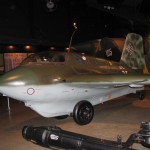
German Rocket Fighter
Private flying must necessarily play a most important part in our future organizations. The writer believes that every normal boy and girl will, in a few years; wish to learn to fly just as they now wish to learn to drive a motor car. Not all of them will wish to continue flying, by any means, but many of them will, either as a profession, a recreation or as a means of travel and transportation.
This calls for an immense expansion of our airport facilities. Not all airports need be in the million dollar class. The minimum is a strip half a mile long and 600 I wide, adjacent to a highway, well drained, graded and sown to turf. Few communities cannot afford this minimum expense, while others which are able to go a step further, should provide a quarter-section, which would give an all-way field, with diagonals of 3,000′ which would accommodate all but the long range heavy aircraft. These now need runways of not less than 4.000′ and the larger types may, within a year or two. They will need concrete runways of eight or ten thousand feet in length. Facilities on this scale will no doubt be provided as the need arises in our major cities and at refueling points on major air routes.
The importance of the expansion of our aerodrome program cannot be over- estimated, and it is suggested that every community should study its individual needs and be prepared to support an airport building program to meets its requirements. If public opinion in each community is awakened and supports such a program, the means will no doubt be forthcoming, but the initiative must come from each community The Department of Transport will be glad to lend assistance through its local staffs in the planning of such facilities and will be ready at all times to advise in the choice of sites, the extent of the development required and other features of the plan. In the past, generous assistance was given by the Federal authorities in the creation of airport facilities and it is reasonable to expect that similar assistance will be forthcoming in future for any well thought out and reasonable program of airport development,
Though no decision has been made by the Federal authorities as yet as to the form or terms on which such assistance might be given. Hand in hand with our airport development will go the expansion of our radio and meteorological services, with all the new developments. Still secret, which will un-doubted increase their efficiency to a marked degree. The growth of our ground facilities will cause a corresponding demand for aircraft of all types and we may expect that a proportion at least of our aircraft industry may be able to survive. There will undoubtedly be a tremendous cut in our production for some years after the war and a shift to the smaller types of aircraft for private use.

Mosquito
On a five year replacement Basis we may look forward to an annual production for domestic uses alone of at least 10,000 aircraft a year within a decade. Most of these will be “puddle jumpers” but there will be a proportion, as yet impossible to predict, of medium sized, single engine, four to five seats; a smaller number of medium twin-engine types of from 12,000 to 20.000 pounds; and a still smaller number of “giant” multi-engine types. Military production alone cannot maintain a sufficient output of aircraft to maintain an adequate industry. There will be ample scope for all the energy and enthusiasm aviation engenders but it must be tempered by caution lest we make the mistake of over- development with subsequent failures and retrogression. Canada’s aviation motto should be in the future, as it has been in the past, “Air power, like sea power, to be effective and permanent must be based on a sound development of peace time uses”.
The preceding excerpt from an old government speech sets out very well the early post Second World War times. So the scene is set for the work of AMEs during and after the Second World War.
The AME profession expanded greatly during Second World War along with the expansion of the aircraft manufacturing industry, which built the hundreds of thousands of aircraft used during the war. The ingenuity and experience of the maintenance technicians kept the air forces flying in the Arctic cold, tropical heat and the dry, sandy deserts. They learned to cope with the humidity of the South Pacific, the sand of the deserts and the brutal arctic cold. They also learned to maintain naval aircraft based on the decks of aircraft carriers and spotter and self-protection aircraft launched from cruisers and battleships.
The experience of the early Licensed Canadian Air Engineers in opening up the airways of Canada and exploring the Arctic and our extensive coasts gave them the practical knowledge to teach the many new recruits. The air forces and naval air of all nations expanded greatly. This of course led to a demand for trained maintenance technicians of all types. The demands of the military lead to a very specialized division of the work. The work was divided up into many technical specialities, unlike the general civilian method of having one multi-tasked Air Engineer or later known as an Aircraft Maintenance Engineer; maintain the aircraft while in service. There was always some specialization in civilian aviation at the shop level and at the component maintenance level but nothing like the military evolved to cope with the war demands.
The construction of aerodromes in the Arctic and Sub-Arctic opened up the great northern reaches of Canada and provided many opportunities for AMEs to work and prosper. This opening lead to the growth of population in the northern mining camps, the demand for more efficient air services became insistent. On the main traffic routes to the far north the length of the “freeze-up” and “break-up” periods was serious. On the shorter runs where there was little difference in latitude, these periods were short; but as the length of the air routes increased, the stoppage of all flights from this cause became intolerable. Ice melted and disappeared at Edmonton, Alberta, early in April, but Bear Lake was still icebound in July. The increase in traffic called for more regular, efficient and uninterrupted service.
In 1937-38 Canadian Airways advocated a chain of landing strips from Mc- Murray to the Arctic Coast along the MacKenzie River and Yukon Southern Airways had made surveys on their air mail route from Grande Prairie to Whitehorse, with strips at Fort St. John, Fort Nelson, Watson Lake and Whitehorse where Pan American Airways, who had been granted landing rights on their route between Juneau and Fair- banks, Alaska, had already graded a strip, with the assistance of the Territorial Government of the Yukon and the Department of Transport, to accommodate the twin- engine transports. Similar work had also been done at Burwash Landing, at Dawson, at Mayo Landing, and at several other points on the chain between Whitehorse and Dawson by the Territorial Government. Yukon Southern Airways had cleared and graded strips at Fort St. John and Fort Nelson, while Canadian Airways had made some progress on the clearing and grading of a strip at McMurray on the MacKenzie River Route. Progress was slow, however, owing to the lack of funds and difficulty of moving heavy grading equipment into these remote districts.
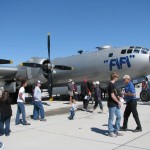
B29
In 1939 the Department of Transport, now Transport Canada, was recognizing the future importance of the air route to Alaska from the commercial and strategic points of view. It obtained authority and funds for a complete airway survey of the route from Edmonton to Whitehorse via the valleys of the Peace, Liard and Yukon Rivers. It was the logical route to Alaska and the Orient, and careful surveys had been made of all the alternative routes during the preceding four years. It lay east of the Rocky Mountains, passed over relatively easy terrain and was climatically preferable to any other route, having a moderate snowfall and freedom from fog at all seasons.
Preoccupation with the construction of aerodromes for the Empire Flying Training Plan during the first two years of the war diverted attention from Northern development, but with the entry of the United States into the conflict in December, 1941, the need for action again became most urgent. Fortunately, the Permanent Joint Board on Defence of Canada-United States, appointed in 1940, had given early attention to the need for better communication with Alaska. It had urged the immediate construction of the North West Staging Route from Edmonton to Fairbanks based on the plans of the Department of Transport. By strenuous efforts the main fields on this route at Grande Prairie, Fort St. John, Fort Nelson, Watson Lake and Whitehorse were completed under contracts let by that Department by September 1st” 1941. After that a steady flow of reinforcements to the United States Air Forces in Alaska was comparatively simple.
During the next three years the route was greatly enlarged, new intermediate fields and radio ranges were added, and the difficulties of transport solved by the completion of the Alaska Highway which gave access to all aerodromes. The construction and early completion of the highway was made possible by the existence of the airway. The decision to exploit to the full the Normal Wells oil field caused a similar revolution of the Mackenzie River air route. The demands of the traffic were far beyond the capacity of the seaplanes previously used with such great advantage. The construction of a chain of full scale air bases was rapidly undertaken by the United States Forces with the approval and assistance of the Canadian Government. Then freight and passenger traffic moved into Normal Wells and Yellowknife in D.C. 3’s, C-46s and from there is distributed by seaplane to outlying points.
On the Atlantic Coast, similar action was being taken to improve the communications by air across the Atlantic. The Department of Transport was authorized to construct new bases at Montreal, Mont Joli, the Saguenay and Seven Islands, Quebec, Moncton, N.B., and Sydney, Nova Scotia; Torbay Newfoundland; and Goose Bay, Labrador. Gander airport was greatly enlarged. The United States Government was also authorized to build airports for their own services at Mingan, Que., Stephenville and Argentia,
Newfoundland. These new bases added greatly to the efficiency and safety of the trans-
Atlantic ferry system and the anti-submarine patrols off the Atlantic and Gulf of St. Lawrence Coasts. In addition they served the important purpose of providing staging aerodromes for the service of the aerodromes built in Greenland and Iceland by the United States Forces.
Later in the war the United States Government was given authority to construct with its own forces a further chain of bases in Northern Canada known as the “Crimson” route, a staging route to provide the shortest route from Los Angeles, California, to Northern European points by short hops. At the time the proposal was put forward the Canadian Government could not see its way to divert men and supplies for this purpose from other projects. It considered that the prospect of opening, before the close of the war, an efficient trans-Atlantic staging route through the Arctic Islands as remote.
However it willingly gave authority to the United States Forces to construct bases at Churchill, Southampton Island, Frobisher Bay, Baffin Island and Chimo, Quebec. In the final settlement of the war accounts between the two Governments, Canada paid the United States $76,000,000.00 for the work done on the “Crimson” route and resumed control of all bases in Canadian territory.
Though never used as a staging route, these bases have been invaluable in the post-war period as stepping stones for further development in the far North. As meteorological stations, bases for the air survey of the Arctic Islands, and as staging bases to aerodromes at still more remote meteorological and scientific stations now being established. This gave more efficient coverage all through the Arctic Archipelago and to similar joint United States and Danish bases in Northern Greenland. Landing strips were built at Baker Lake, Eureka Sound, and Cornwallis Island. It was then proposed to build a strip near all meteorological stations established there thus bringing to completion the ideas originally put forward in 1922 by the Air Board who had sent R.A. Logan to make a reconnaissance for this purpose.
During Exercise “Musk-Ox”, a joint exercise by the Canadian Army and the R. C. A. F. to test the possibilities of moving men and motorized transport in the Canadian Arctic during the winter and spring of 1945, the moving force was supplied by air during its entire journey of 3000 miles from bases at Churchill, Yellowknife and Norman Wells. Landings were made by “Dakota” aircraft; at many of these new bases and on the sea ice at various points on the route. On one occasional 8 1/2 tons of supplies were dropped by parachute at Perry River on the Arctic Coast in an hour by six Dakotas, four from Churchill and two from Yellowknife. During the last two winters numerous mercy flights to evacuate sick or injured persons have been made possible by the use of the new bases and the construction and supply of the remotest meteorological stations have been greatly facilitated.
The above brief account shows the gradual expansion from, small beginnings, of flying in Northern Canada. Progress has been steady throughout the years. The foresters and surveyors were the leaders in 1919, followed quickly by the prospector and mining operator. Aviation and mining went hand in hand during the 1920’s and 1930’s. With the increase in efficiency of the flying services, the range of prospecting and mining penetrated ever further into the North. The war brought a revolution in methods and saw the aerodrome system extended into the far North. Today it is possible to travel to the Arctic Coast of Canada, to the Arctic Archipelago and to Alaska with equal safety and comfort in the same types of twin and four-engine planes; with equally efficient radio aids to navigation and meteorological services, and comparable ground facilities to those in common use between Toronto and Montreal or New York and Chicago.
Journeys which previous to the advent of the aeroplane took months and even years of arduous travel are now accomplished with ease and comfort in a few hours. The isolation and solitude of the Arctic are a thing of the past! With regular air mails, radio and supplies of fresh provisions, life in the Arctic has assumed an entirely different complexion.
Each month of the First World War 1914-18 saw a constantly increasing demand For more aircraft, first for observation, then to fight the observation planes, and, finally, for bombing military objectives. Young Canadians flocked eagerly into the new service and acquitted themselves so well that the Royal Flying Corps established training bases in Canada to enlarge their field of recruitment and supplement their overcrowded home training establishments. Camp Borden, Leaside, Armour Heights, Desoronto, Mohawk and Beamsville were all active flying training schools and Toronto University became the centre of their ground training activities.
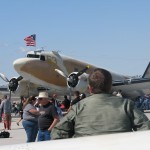
DC3
History repeats itself when the crisis came in the end of August, 1939; it was natural that Canada should again play an important part in the War in the Air. This time the need was much more urgent. With the expansion of the Royal Air Force, the air space of the United Kingdom was rapidly approaching saturation. Every month saw the creation of new squadrons as the output of aircraft rose. Each new unit required another aerodrome for operations and this, coupled with the expectation or intensive air fighting and the continuous bombing of all aerodromes, made it essential to find other bases where training could proceed without these distractions. Canada was the only practical outlet.
Canada’s accessibility, the satisfactory experience of training in the World War and the known enthusiasm of her youth for the air, made it inevitable that she should become a great flying training centre for the British Empire. Missions from the United Kingdom, Australia and New Zealand reached Ottawa in September and, though a final agreement was not concluded till December, the scale and scope of the plan were determined early in October so that preparatory work could be put in hand.
TRAINING SCHOOLS REQUIRED
The original British Commonwealth Air Training Plan program provided for sixty-tour flying training schools, twenty of which were to be opened in 1940, the first in June, thirty-six in 1941, and the remainder during the first half of 1942. Events subsequent to April, 1940, modified this program greatly, have increased its tempo and enlarged its scale. Of the original sixty-four schools, twenty-six were Elementary, ten were Air Observers, ten Bombing and Gunnery, two Air Navigation, and sixteen Service Flying Training Schools where intermediate and advanced training is given. At each of the service flying training schools the establishment of aircraft of various types is so large that when the school is in full swing two Relief aerodromes were necessary to avoid congestion on the Main aerodromes. The program therefore, called for aerodromes for ninety-six units.
The Royal Canadian Air Force, hampered for many years by lack of funds for aerodrome construction, had at the outbreak of war only five aerodromes ready for use and six under construction. Their auxiliary squadrons were all based on civil airports. The service aerodromes were, of course, required tor operations immediately the war began and were not available for the training plan.
Due to the energetic support of the Honourable C. D, Howe there had been great activity in the building and improvement of civil airports in all parts of the country since 1936. This was principally along the line of the Trans-Canada airway but included many airports to serve feeder lines as well, the use of this chain of airports, built to a common, up-to-date standard, as a foundation for the plan, was the obvious solution of the problem. The Civil Aviation Division was called into consultation by the middle of October and the decision reached soon after that the responsibility for finding and building the aerodromes required for the program should rest on it.
A quote, “A cataclysm of the magnitude of the present war affects all civil activities. Aviation has no exception. Every phase of flying has been gravely affected by the change-over from peace to war. While meeting the Air Force requirement in all respects, the aim of the Department of Transport, Civil Aviation, has been to ensure that when the time comes to return to normal peace conditions, as much as possible of the war effort and expenditure may be adapted to increasing the facilities for civil air transport in the Dominion. The aerodrome situation at any rate will be vastly improved.
The size of all the main aerodromes on the trans-Canada airway and its principal feeder lines has been increased. New hard surfaces have been added and many fuel hangars and other buildings have been built on the aerodromes. Some of these no doubt will still be required by the R.C.A.F. when the war is over but much may be surplus to their requirements and can be made available for the expansion of our civil transport services. In addition, aerodromes have been built to serve many new districts.
Speaking to a Montreal audience one naturally takes the local situation as an illustration of what is happening in all parts of the country. St. Hubert, the old civil airport, will next summer be turned over to the R.C.A.F. and a new airport designed on modern lines and complete with all facilities will be ready for use by the civil air transport services. The new airport will, at the same time, accommodate an Air Observers and a Wireless school for the duration of the war.
The successful execution of this program has been due in the first place to the vision and initiative of the Honourable C.D. Howe, Minister of Transport and Minister of Munitions and Supply. In both capacities he has been head of services intimately connected with the war effort. As Minister of Transport he was responsible for the organization of the trans-Canada system, which has been the basis of this program and without which the rapid progress made would not have been possible.”
The above quote found is some old papers really gives one the scale of the blossoming of aviation in Canada and its requirements for AMEs. Civilian AMEs were employed in the airlines and bush operations that continued during the War. They also found jobs as aircraft and component inspectors in the military production systems. Airworthiness Inspection delegates were mostly AMEs, a tradition which carries on in many of today’s delegates from Transport Canada.
The foundation of the cross Canada aviation technical trade system was built during these years as well. Toronto Central tech had been around for most of the century, followed by places like the Southern Institute of Technology in Calgary. Gradually the system expanded across Canada and tech colleges can now be found in all parts of the country.
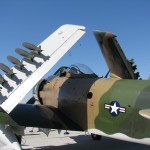
Sky Raider
The technology in both aircraft manufacturing was changing as was the complexity of the aircraft systems. This all set the stage for the introduction of jets and turbine power into the post war civilian world. That fact, together with the electronic revolution caused by the war, brought major changes to all later AMEs, including the licensing and oversight system itself.
The effect of the war on aircraft maintenance was felt into the nineteen seventies. When I joined the Ministry of Transport in 1975, we still had maintenance inspectors working there that had been Airworthiness Inspection Division Inspectors during the war at aircraft and component manufacturing facilities. The regulatory system in civil aviation manufacturing and maintenance was very much continued on from the 1940-1945 period. Resident inspectors at facilities were still commonly employed. Much regulatory compliance was simply accomplished by the fact everyone seemed to know everyone else in the industry and workmanship pride was the watch word. The advancing of the use of electronics in aircraft systems was bringing forward a new trade, avionics. A general move was being made away from personal skill and responsibility to a systems approach. These factors and changing society led to many fundamental changes in the way AMEs were trained and licensed and how the then newly named Transport Canada was to regulate them in the latter part of the twentieth and the twenty-first centuries.